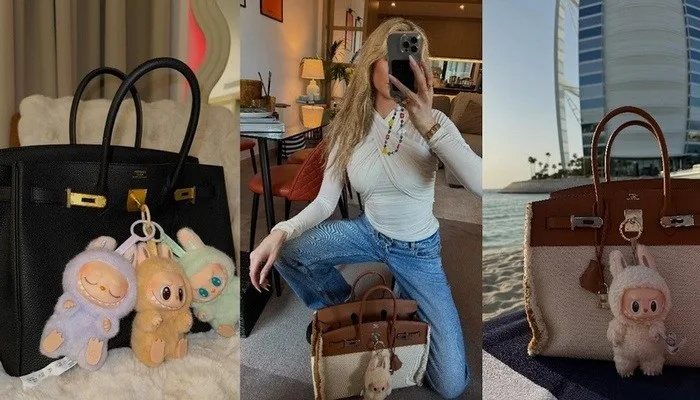Comme des Garçons & Labubu: When High Fashion Taps Into Art Toy Whimsy
In a world where creativity constantly reinvents itself, boundaries between art, fashion, and culture are fading faster than ever. From museum installations to pop culture collectibles, creative expression has evolved into something far beyond its traditional categories. Two distinct forces leading this evolution — though worlds apart — are Comme des Garçons and Labubu.
At first glance, the avant-garde precision of Comme des Garçons and the playful mischief of Labubu seem to live in entirely different universes. One challenges the fashion system; the other thrives in the world of art toys and collectible culture. Yet, what ties them together is their shared defiance of norms — a fearless dedication to self-expression that transcends labels, markets, and expectations.
Comme des Garçons: Redefining Fashion as Art
Since its inception in 1969 by the visionary Rei Kawakubo, Comme des Garçons has never been just a fashion brand — it’s been an artistic rebellion. Where others chase trends, Comme des Garçons creates philosophies. Kawakubo built a world that redefines beauty through imperfection, structure through chaos, and fashion through emotion.
Every Comme des Garçons collection feels like a story told through fabric — sometimes fragmented, sometimes poetic, but always thought-provoking. The brand’s signature approach to deconstruction, asymmetry, and anti-fashion silhouettes revolutionized the runway, challenging the industry to rethink what clothing means.
Unlike conventional labels, Comme des Garcon (https://commedegarconsofficial.com/) doesn’t aim to beautify the wearer — it aims to make them think. Each design embodies intellectual freedom, rebellion, and emotional honesty. Kawakubo’s pieces are wearable sculptures, evoking questions more than answers. That’s precisely why the brand commands such cult respect: it never compromises its artistic integrity for mass appeal.
From the haunting collections of the 1980s to its evolving design experiments, Comme des Garçons continues to explore contrasts — restraint and excess, fragility and strength, logic and absurdity. Even its retail spaces, designed like conceptual art galleries, reflect its mission to challenge expectations.
In essence, Comme des Garçons doesn’t follow fashion — it defines it, then dares to destroy it.
Comme des Garçons PLAY: Simplicity Meets Iconic Expression
Among its many sub-labels, Comme des Garçons PLAY stands out for bringing the brand’s creative DNA into everyday wear. PLAY is instantly recognizable for its minimalist designs and the iconic heart-with-eyes logo created by artist Filip Pagowski.
Where the main Comme des Garçons line is avant-garde and conceptual, PLAY celebrates approachable creativity. Its T-shirts, hoodies, and sneakers balance simplicity with bold identity — making it one of the most beloved streetwear crossovers in the luxury world.
PLAY captures the essence of youthful rebellion but in a friendly, wearable form. The heart logo — both playful and mysterious — represents individuality and emotion, two things at the core of the brand’s spirit. It bridges the gap between high fashion and casual culture, showing how even the most artistic brands can connect with daily life.
Through Comme des Garçons PLAY, the brand proves that art and accessibility can coexist — style doesn’t need to shout to be revolutionary.
Labubu: The Mischievous Heart of Art Toy Culture
On the other end of the creative spectrum lies Labubu, a name that’s become iconic in the world of designer toys and pop art collectibles. Created by artist Kasing Lung under the Hong Kong-based brand How2Work, Labubu is instantly recognizable — a small, wide-grinned creature that feels both eerie and adorable.
Labubu is not about perfection; it’s about personality. With its sharp teeth, curious eyes, and mischievous grin, the figure embodies the whimsical and emotional world of contemporary art toys. While it might appear childlike, its design carries layers of meaning — nostalgia, imagination, and a touch of darkness that resonates deeply with collectors around the world.
Art toys like Labubu represent a new era of creativity — one where art moves beyond museums and galleries to become part of everyday culture. Collectors don’t just buy these figures; they connect with them emotionally. Each piece feels personal, like holding a fragment of someone’s imagination.
Labubu Dolls & Keychains: Whimsy You Can Carry
As Labubu’s popularity has grown, so has the variety of its expressions — from collectible figures to Labubu dolls and keychains. These pieces allow fans to carry the character’s playful energy beyond display shelves and into daily life.
The Labubu dolls capture the same mischievous charm in a softer, more tactile form — plush versions that retain the brand’s quirky, emotional edge. They blur the line between art object and comfort item, appealing to both collectors and casual fans.
Meanwhile, the Labubu keychain has become a street-culture favorite. Small yet instantly recognizable, they bring a spark of individuality to everyday accessories — backpacks, keys, or even fashion pieces. The combination of high-quality design and expressive detail makes them a perfect reflection of how art toys are evolving into lifestyle statements.
Through these creations, Labubu transforms from a collectible to a companion — a reminder that art can live not only on shelves but in the small details of our daily routines.
Two Worlds, One Creative Energy
Though Comme des Garçons and Labubu operate in different creative dimensions, their philosophies run strikingly parallel. Both challenge the mainstream by celebrating the unconventional. Comme des Garçons distorts the human silhouette to explore identity, while Labubu distorts the human spirit into a fantastical form that mirrors innocence and mischief.
Both reject mass-market ideals — one in the realm of haute couture, the other in collectible art. They thrive in spaces where creativity comes first, and commercial logic comes later.
In many ways, their connection is philosophical rather than visual. Comme des Garçons explores existential beauty — what it means to be human, flawed, and expressive through the medium of fabric. Labubu, meanwhile, does the same through sculpted resin, plush, or plastic — small yet powerful vessels of emotion.
This shared mindset of experimentation and storytelling places both at the forefront of modern creativity. Neither seeks to please; both aim to provoke, inspire, and connect.
Cultural Crossroads: Expression Over Conformity
In today’s creative landscape, audiences don’t just “buy” they “belong.” They connect with brands that represent individuality and authenticity. Comme des Garçons and Labubu cater to this mindset, where people value emotional resonance over trends.
The crossover between fashion, art, and collectibles isn’t about merging products; it’s about merging emotions. Fashion lovers appreciate the artistry behind toys like Labubu, while toy collectors admire the philosophical depth behind brands like Comme des Garçons.
This shift represents the democratization of creativity — where boundaries dissolve, and new forms of expression emerge. Comme des Garçons and Labubu (https://labubudollshop.us/) prove that creativity doesn’t fit into boxes; it expands beyond them.
Why Their Contrast Matters
The magic lies in their difference. Comme des Garçons is rooted in structure and theory. Labubu thrives in emotion and playfulness. One challenges intellect; the other awakens imagination.
And yet, both resonate with the same creative audience — people who see art not as a product, but as identity. Comme des Garçons invites you to think; Labubu invites you to feel. Together, they represent the duality of modern creativity — rational and emotional, refined and rebellious, human and fantastical.
The New Generation of Creators and Collectors
A new creative generation has emerged — one that sees no boundaries between disciplines. Young designers, artists, and collectors draw inspiration from both the avant-garde and the playful. They wear Comme des Garçons not for its logo, but for its language. They collect Labubu not for prestige, but for connection.
This mindset defines modern creativity: to mix, to express, to belong nowhere and everywhere at once.
Comme des Garçons and Labubu may never share a runway or a shelf, but they share something far deeper — a belief that imagination has no limits.
Conclusion: Creativity Beyond Categories
When we look at Comme des Garçons and Labubu side by side, we don’t see a collaboration — we see a conversation between two worlds. One speaks through fabric, the other through form. One represents the intellect of art, the other its heart.
Both remind us that creativity is not defined by category but by vision. Whether it’s the haunting elegance of a Comme des Garçons silhouette or the mischievous grin of a Labubu keychain, both invite us to see beauty in the unexpected — and to carry that imagination wherever we go.
Comme des Garçons and Labubu don’t belong to the same world — and that’s exactly why they inspire the same generation.



